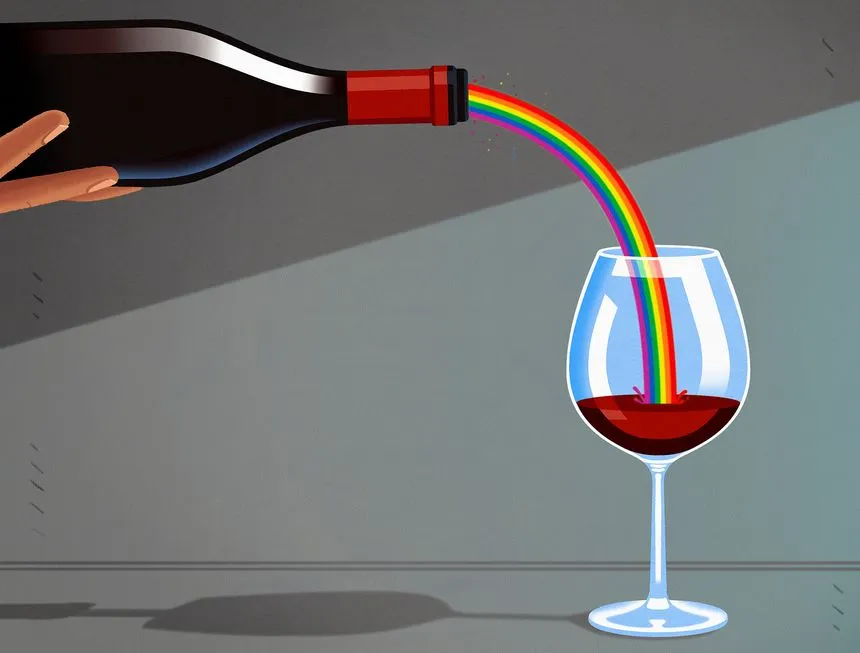Why is alcohol in wine a taboo subject?
When we talk about wine, we talk about many things – the taste, the aroma, the source – but we rarely talk about the alcohol it contains and how it affects us.

Four middle-aged men are sitting in a restaurant; three are drinking champagne. They laugh at the outlier and eventually convince him to have a drink.
This scene comes early in the critically acclaimed 2020 Danish film “Another Round” (“Druk” in Danish). It centers on four friends who decide to test a theory that their lives would be better if they only raised their daily blood alcohol levels. The theory attributed to Norwegian psychiatrist Finn Skårderud – erroneously, Mr. Skårderud insisted, based on a misreading of his writings – that people are born with a 0.05 percent alcohol deficiency and that by increasing this level, their lives would become richer and more fulfilling. friends start drinking regularly, what happens is both predictable and unpredictable. At times uplifting and at times depressing, this movie got me thinking about the appeal of alcohol.
I don’t mean excessive drinking – although that certainly happens in movies and in life. That’s probably why no one I know talks about the appeal of alcohol. A drinker might notice that a particular bottle is high or low in alcohol based on the percentage listed on the label. But that’s about the same as the alcohol content.
Even wine professionals avoid mentioning the appeal of alcohol when describing a particular wine. They may pick out attributes such as aroma, texture, origin and history, or even price and scarcity to praise or scorn. I have never read a tasting note on a retailer’s website or shelf, nor have I ever heard a sommelier describe how she or he felt after drinking a glass or two of a particular Burgundy or Napa Cabernet Sauvignon. For that matter, I’ve never written such tasting notes myself.

Alcohol, however, is the inevitable result of grape juice fermentation and is clearly one of the most attractive ingredients to those who drink it. As Napa winemaker Aaron Pott said in an email, “The reason we decided to harness the power of rotting fruit was because of what it did to us. It changed the mind. It made us feel good to say crazy s-t, to lose our inhibitions, to stop and look at the stars. It is the best part of wine. Without it, Western culture and philosophy would be different.”
As novelists, playwrights, poets and film directors have often described, the alcohol in wine can certainly provide soothing, calming pleasure, even delight. In his 1964 memoir “A Flowing Feast,” Ernest Hemingway recalls a long-ago trip through France with F. Scott Fitzgerald, during which they drank a lot of “white merkanser” (a simple white Burgundy wine). “At that time in Europe, we considered wine to be healthy and normal food and a great giver of happiness, well-being and pleasure,” he wrote. On the other hand, as Hemingway adds a few pages later, he realized that his traveling companion was not well served by wine: “It was obvious that he should not drink anything, and that I was not taking good care of him. Anything he drank seemed to stimulate him too much and then poison him, and I planned to keep all drinking to a minimum the next day.” Sadly, by the time Hemingway wrote these words, he himself had long been worse for alcohol.
Four friends of “Another Round” cited Hemingway when they began their drinking experiment. They would only drink during work hours, “just like Hemingway,” one friend declared – although their drinking gradually seeped into the rest of the day and eventually took over their lives, just like Hemingway’s did.
Remarkably, many of the literary figures most plagued by (too much) alcohol were the ones who described their appeal so well. Sir John Falstaff in Shakespeare’s “Henry IV, Part 2” captures the benevolent feeling that good wine can bring: “It gets me into the brain; dries up all the foolish, dull and sticky vapors around me; makes it apprehensive, quick, forgetful, full of dexterous fire and delightful shapes, which, after passing to the voice, become, as born tongues, superbly wise.”
I felt a little witty after a glass or two of wine myself and saw the effect in a friend – although there was no discussion of the role of alcohol in relaxing our tongues. When I asked my friend Robert, a wine collector, if he ever thought or talked about alcohol in wine, his answer was yes. “There’s more to the wine experience than that,” he said, perhaps a little prurient. I continued: Isn’t alcohol part of the appeal of wine? Robert admits that it is, but adds a caveat: “It’s important to know when to stop.”
“The reason we decided to use the power of rotten fruit was because of what it did to us. That changed the mind.”
Tahiirah Habibi, sommelier and founder and CEO of the Hue Society, an organization dedicated to increasing access to the world of wine for black, brown and indigenous professionals, said wine professionals rarely discuss the pleasures of alcohol. stigma,” especially among female wine professionals.
While I agree that this particular stigma is commonplace in American culture, the French have long valued the pleasures of alcohol in wine more. “We say in France that if soldiers hadn’t had a bottle of wine a day during World War II, we would have lost the war,” Véronique Boss-Drouhin, winemaker at Drouhin Winery and Burgundy estate Joseph Drouhin in Oregon, said in an email. While Ms. Boss-Drouhin noted that a wine is not a wine without alcohol, she also issued a warning, “It’s too tricky to associate pleasure with alcohol these days.”
World War II scholars might point out that Sir Winston Churchill was an extraordinary wine lover before, during and after the war. He was particularly enthusiastic about the Beaufort Roger champagne. The Champagne House has rewarded the great statesman by naming their top specialty wines after him. “A glass of champagne gives a feeling of euphoria. Nerves are braced, the imagination is pleasantly stimulated, the intellect becomes more flexible,” Churchill wrote. However, he further noted that “the bottle produces the opposite effect. Too much can lead to stupor and insensibility.”
At the end of “Another Round,” the character Martin (played by Mads Mikkelsen) and his friends happen upon a group of young men dancing and drinking. Martin walks through the crowd; they spray him with beer and champagne. He takes a sip of his drink and does a cheerful ballet. The final frame of the film is deliberately ambiguous. Has Martin finally become more conscious, more connected – or has he destroyed himself? This ambiguity is arguably present at the heart of the wine.
